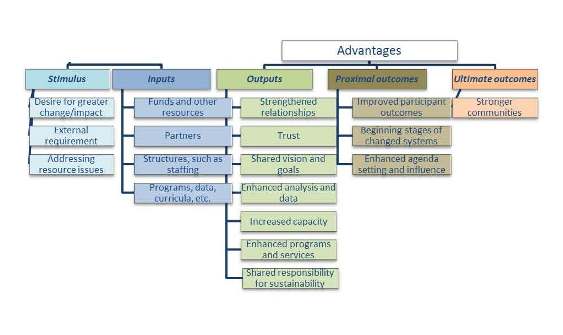People engage in collaboration for a number of good reasons:
 © 2006, the Improve Group
Not all collaborations are effective, however. In order to achieve these outcomes, collaborative efforts must have a combination of factors that build individual members’ commitments to the collaboration and help the collaboration achieve results. Hanna Cooper, a certified team coach based in St. Paul, cites fourteen characteristics of high-performing teams.[1] The highlighted items were referenced frequently in our research.
© 2006, the Improve Group
Not all collaborations are effective, however. In order to achieve these outcomes, collaborative efforts must have a combination of factors that build individual members’ commitments to the collaboration and help the collaboration achieve results. Hanna Cooper, a certified team coach based in St. Paul, cites fourteen characteristics of high-performing teams.[1] The highlighted items were referenced frequently in our research.
 Note that camaraderie and communication are also strengths of high-performing teams, and maybe some of the best motivators for individuals to participate in collaborative efforts. Your colleagues might be more willing to contribute to the work if some fun and relationship-building is incorporated.
You may be part of several collaborations: across departments in a large organization, with agencies that have similar services, or with agencies with very different services who are serving the same population or addressing the same problems. Reflecting on the advantages you gain as a collaborative and the strengths you should build as a team can help you make a greater impact.
To learn more, join us at our next interactive, online, free chat for nonprofit and public leaders. Our next chat, Making the Most of Partnerships and Collaboration, is on Wednesday, September 8th from 8:30-9:30 am. To attend, RSVP to susanm@theimprovegroup.com.
Note that camaraderie and communication are also strengths of high-performing teams, and maybe some of the best motivators for individuals to participate in collaborative efforts. Your colleagues might be more willing to contribute to the work if some fun and relationship-building is incorporated.
You may be part of several collaborations: across departments in a large organization, with agencies that have similar services, or with agencies with very different services who are serving the same population or addressing the same problems. Reflecting on the advantages you gain as a collaborative and the strengths you should build as a team can help you make a greater impact.
To learn more, join us at our next interactive, online, free chat for nonprofit and public leaders. Our next chat, Making the Most of Partnerships and Collaboration, is on Wednesday, September 8th from 8:30-9:30 am. To attend, RSVP to susanm@theimprovegroup.com.
[1] Based on those identified in the Team Diagnostic™ Assessment, www.teamcoachinginternational.com.
- A problem may seem larger than can be addressed with just one organization’s expertise
- Limited resources may force organizations to think about how they can pool efforts and resources
- An external force may require collaboration – for example, a funder, or a joint powers board
Figure 1: Model of collaborative advantage
 © 2006, the Improve Group
Not all collaborations are effective, however. In order to achieve these outcomes, collaborative efforts must have a combination of factors that build individual members’ commitments to the collaboration and help the collaboration achieve results. Hanna Cooper, a certified team coach based in St. Paul, cites fourteen characteristics of high-performing teams.[1] The highlighted items were referenced frequently in our research.
© 2006, the Improve Group
Not all collaborations are effective, however. In order to achieve these outcomes, collaborative efforts must have a combination of factors that build individual members’ commitments to the collaboration and help the collaboration achieve results. Hanna Cooper, a certified team coach based in St. Paul, cites fourteen characteristics of high-performing teams.[1] The highlighted items were referenced frequently in our research.
 Note that camaraderie and communication are also strengths of high-performing teams, and maybe some of the best motivators for individuals to participate in collaborative efforts. Your colleagues might be more willing to contribute to the work if some fun and relationship-building is incorporated.
You may be part of several collaborations: across departments in a large organization, with agencies that have similar services, or with agencies with very different services who are serving the same population or addressing the same problems. Reflecting on the advantages you gain as a collaborative and the strengths you should build as a team can help you make a greater impact.
To learn more, join us at our next interactive, online, free chat for nonprofit and public leaders. Our next chat, Making the Most of Partnerships and Collaboration, is on Wednesday, September 8th from 8:30-9:30 am. To attend, RSVP to susanm@theimprovegroup.com.
Note that camaraderie and communication are also strengths of high-performing teams, and maybe some of the best motivators for individuals to participate in collaborative efforts. Your colleagues might be more willing to contribute to the work if some fun and relationship-building is incorporated.
You may be part of several collaborations: across departments in a large organization, with agencies that have similar services, or with agencies with very different services who are serving the same population or addressing the same problems. Reflecting on the advantages you gain as a collaborative and the strengths you should build as a team can help you make a greater impact.
To learn more, join us at our next interactive, online, free chat for nonprofit and public leaders. Our next chat, Making the Most of Partnerships and Collaboration, is on Wednesday, September 8th from 8:30-9:30 am. To attend, RSVP to susanm@theimprovegroup.com.
[1] Based on those identified in the Team Diagnostic™ Assessment, www.teamcoachinginternational.com.
